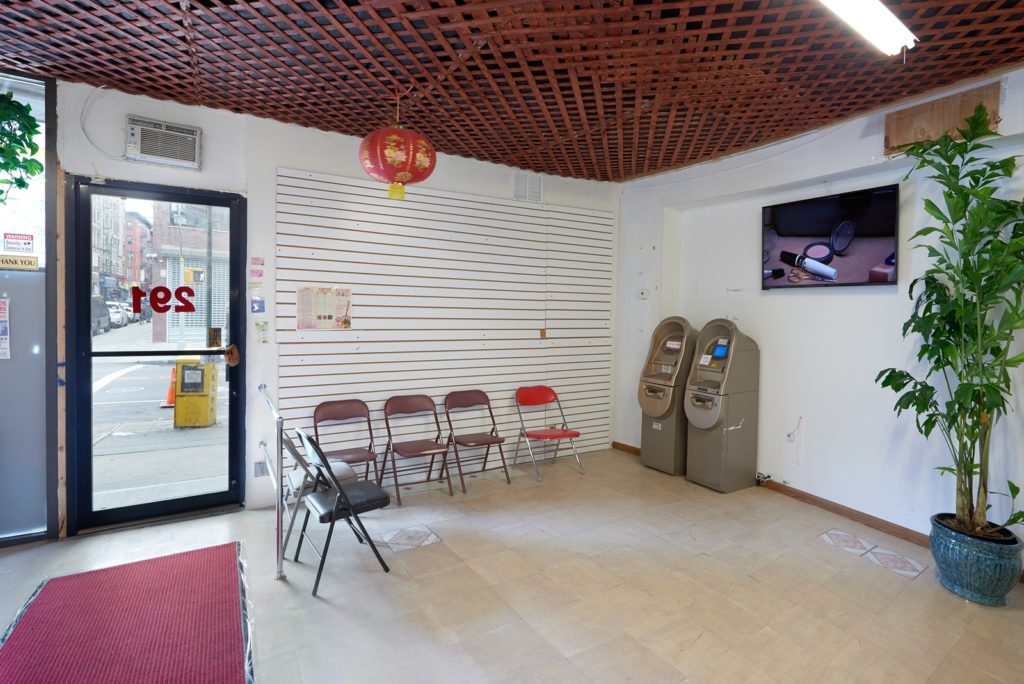Art World
‘I Expect This From Right-Wing Trolls Carrying Tiki-Torches’: Omer Fast Responds to Protests of His Chinatown Installation
Local community organizations have said the show "reifies racist narratives."

Local community organizations have said the show "reifies racist narratives."

Brian Boucher

Omer Fast’s latest exhibition at New York’s James Cohan Gallery has become the subject of citywide debate after coming under fire from community members who say it perpetuates harmful stereotypes. Held at the gallery’s Chinatown location, the show recreates a derelict storefront complete with Chinese menus, dented walls, and graffiti. Now, the artist has responded to his critics in a statement posted to the gallery’s website.
Demonstrators—including representatives from the groups Chinatown Art Brigade, Decolonize This Place, and Art Against Displacement—gathered at the gallery to protest on Sunday, October 15, with signs that read, “Chinatown Lives Are Not Poverty Porn” and “Displace Racist Art! Not Chinatown Tenants!”
But Fast has made it clear that he has no plans to withdraw the work, which he says is intended to serve as a complex commentary on immigrant identity. He sought “to recreate what the space looked like before the gallery moved in almost two years ago” in order to explore “how to reconcile a foreign identity with a local one.” (As ARTnews points out, the space’s previous tenant was HK Manpolo Market, a grocery store.)

Installation view, “Omer Fast: August,” James Cohan, New York, 2017. Photo: Phoebe d’Heurle.
Protesters do not view the show this way. “The conception and installation of this show reifies racist narratives of uncleanliness, otherness and blight that have historically been projected onto Chinatown,” the Chinatown Art Brigade wrote in a letter to the gallery on October 2. “Your appalling exhibition should be shut down.”
(Among those present at this weekend’s demonstrations, according to Hyperallergic, was another Chinatown dealer, Margaret Lee of 47 Canal, who founded the anti-gentrification group Art Against Displacement.)
James Cohan Gallery is standing by the work. The gallery released its own statement alongside Fast’s that describes the installation as “an intentionally-uncomfortable look inward.” The gallery added: “People are free to draw their own conclusions about art, but they should also be given the opportunity to do so—without censorship, barriers or intimidation.”
For his part, Fast said he is “not surprised there have been critical reactions.” Read the artist’s statement in full below:
As part of my first exhibition at James Cohan’s Chinatown gallery, I decided to transform the facade and interior in a symbolic and temporary act of erasure. I wanted to erase the passage of time and to recreate what the space looked like before the gallery moved in almost two years ago. The tall glass facade and white-cube interior would disappear and the space would lose its more recent identity as an upscale gallery. The back spaces, where the gallery’s business takes place, were left untouched. No one working there was asked to perform or do anything different. As such, there was nothing radically transformative about this intervention since it was neither disruptive nor permanent. I’m aware how superficial such a formal transformation might seem, but I was precisely interested in this conflict between appearance and essence.
As a teenage immigrant to the United States and a naturalized American, I’ve long felt the tension between appearance and essence. I know many first- and second-generation immigrants experience the same challenge: how to reconcile a foreign identity with a local one, how to connect old and new, outward facade and inner space. In the case of the intervention at James Cohan, the actual gallery is being used as an immigrant surrogate: a transplant that tries to affect an appearance and blend in, even while its essence is undeniably foreign. I suspect many of the critical reactions to my work have a lot to do with this tension between appearance and essence.
I’m not surprised there have been critical reactions. I completely understand people’s need to push back. We all have unseemly baggage, racist and otherwise, that needs to be sorted through. We all overstep bounds and must shine a light on our darker hypocrisies, myself included. For good and for bad, artists do this in public. But I am surprised and distressed by the vitriol and name-calling. A group of protestors hanged a large poster outside the show, which accuses the gallery of representing “a non-US and non-New York artist.” I expect this sort of characterization from right-wing trolls carrying tiki-torches and howling for walls to be built. I don’t expect it from left-wing activists in lower Manhattan.
This doesn’t mean that displacement and gentrification are not happening, nor that artists and galleries do not contribute to these processes, nor that I’m somehow magically free from prejudiced thinking and above all that. I’m truly sorry that some persons find the installation insensitive or offensive. The point of this work was never to insult or incite but to talk about identity and immigrant experience – my immigrant experience – warts and all, in its complexity and in its contradictions, pitting essence against appearance. For what it’s worth, I think this is what this work does. I’ve asked the gallery not to take down the protesters’ posters. I disagree with their statements about me and my work but I think they’re important to consider as part of a larger picture.
Omer Fast’s exhibition “August” is on view at James Cohan Gallery, 291 Grand Street, New York, through October 29.